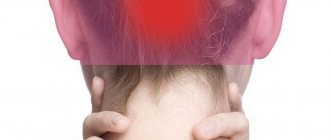Fainting is a sudden, short-term loss of consciousness. Caused by a deterioration in the blood supply to the brain resulting from stress (trauma, the sight of blood, pain). Prolonged stay in a stuffy room, in case of intoxication, infectious diseases. As a result of any of the reasons, blood and, consequently, oxygen begin to flow poorly into the brain. In this case, dizziness and nausea often occur; the skin becomes cold and damp, the child loses consciousness. In a sense, fainting is a protective mechanism: when a person falls, in a horizontal position, blood flows better to the brain, and consciousness soon returns. In most cases, this happens within a minute; after fainting, the child is correctly oriented, but may still feel weak and dizzy for some time.
Fainting lasts from 1 to 3 minutes and is manifested in addition to weakening or loss of consciousness by a drop in blood pressure and slowing down. And then an acceleration of the heart rate, cold sweat. Relaxation of muscles. Fainting in children under 10 years of age is rare. In adolescence, fainting occurs often, especially in girls. A single case of fainting, as a rule, does not mean that a teenager is seriously ill. However, if this is your first time fainting, contact your pediatrician . He must rule out possible serious illnesses as the cause of fainting (for example, cardiac arrhythmias or brain disease).
URGENT CARE
Call an ambulance if the child loses consciousness and:
- not breathing
- convulsions started
- skin turned blue
- shallow breathing, rapid pulse
- unconsciousness lasts more than a minute
ATTENTION!
If your child feels dizzy, place him on his back and raise his legs 30 degrees. In this position, blood begins to flow better to the brain and heart. If he cannot lie down, have him sit with his head down. Loosen tight clothing so your baby can breathe easily. You must remain in this position for at least 5 minutes.
| ASK YOURSELF A QUESTION | POSSIBLE REASON | WHAT TO DO |
| Does your teenager complain of dizziness when standing up suddenly? Are you often pale and tired? | Orthostatic hypotension (a sharp drop in blood pressure with a rapid change in body position); anemia | Dizziness is a common symptom and does not necessarily indicate a serious illness. With orthostatic hypotension, control of the tone of the veins has weakened, and the blood does not have time to quickly return to the brain when the teenager suddenly stands up. Make sure your child drinks enough fluids and does not change his body position suddenly. If your child is often pale and tired, he should be examined by a pediatrician to see if treatment is needed. |
| Before fainting, was the teenager breathing quickly and shallowly? Do you have attacks of fear accompanied by hyperventilation (frequent and shallow breathing)? | Hyperventilation; panic attacks; anxiety (see Anxiety); depression | Try to understand what situations or people cause emotional stress in your child. The pediatrician may advise you to consult a psychologist and recommend medications |
| Before losing consciousness, was the teenager exposed to the sun for a long time or in a stuffy, hot room - at a school meeting, for example? Is he usually healthy and active? | Heatstroke; dehydration; lack of fresh air | The child should be left alone until he feels well. Offer cool water as soon as he can drink. If this is your first time fainting, contact your pediatrician. |
| Did the teenager pass out during a coughing fit? Does he cough often or wheeze, especially at night or during physical activity? Diagnosed with asthma? | Asthma | Seek medical attention immediately. The pediatrician will recommend treatment |
| Did the teenager complain of weakness or dizziness? Has he not eaten for a long time? Or did he eat a lot at once, especially sweets, on an empty stomach? | Low blood sugar | Give your child sweet food or drink (sugar, condensed milk, cookies). Contact your pediatrician . Try to control your diet. Food should contain a balanced amount of carbohydrates, protein and not a lot of fat. |
| Does your child have diabetes? | Diabetes | If a child with diabetes loses consciousness, call an ambulance immediately |
| Did you suddenly experience dizziness, difficulty breathing, or loss of consciousness? Is your skin damp? Frequent weak pulse? Widespread skin swelling? Has your child been bitten by an insect, is he allergic to a food, or has he started taking some new medicine? | Anaphylaxis (severe allergic reaction) | This is an emergency: call an ambulance . Urgent medical attention is required. Until the doctor arrives, perform cardiopulmonary resuscitation. |
| Has your teenager lost consciousness several times after physical or emotional stress? Have there been any complaints from the heart? | Arrhythmia attack | Contact your child's doctor immediately . He will make a diagnosis and recommend treatment (see Heart rhythm disturbances) |
| Is a teenage girl experiencing fainting and nausea for several days in a row? Is she withdrawn and seems worried? Do you have reason to believe that she may have a sexual partner? | Pregnancy | Talk calmly to your daughter. If you think she may be pregnant, talk to your baby's doctor right away |
FOR INFORMATION
In addition, fainting can develop against the background of chronic lung diseases, calcification of the vertebral arteries (which occurs in adolescents and older adults).
What is fainting and its symptoms
Fainting is a short-term loss of consciousness caused by metabolic disorders in the brain. Symptoms of impending fainting in a child are:
- dizziness;
- noise in ears;
- severe weakness;
- nausea;
- blurry vision;
- pale skin;
- increased sweating.
Fainting in a child, as a rule, is very frightening for parents. And for good reason, as this may be evidence of serious health problems.
Republican Children's Clinical Hospital
Fainting is a short-term loss of consciousness caused by a decrease in blood supply to the brain. Pathology of the nervous system is not always the root cause of fainting. Most often they develop against the background of somatic pathology.
Clinical picture of fainting
Fainting is characterized by muscle weakness, decreased tone, inability to stand upright, and loss of consciousness. The term "weakness" denotes a lack of strength with a feeling of impending loss of consciousness. At the beginning of fainting, the patient is always in an upright position, i.e. he is sitting or standing. Usually the patient has a premonition of impending fainting - there is a feeling of “not feeling well.” Then there is a feeling of movement or swaying of the floor and surrounding objects, the patient yawns, spots appear before the eyes, vision is weakened, tinnitus may occur, nausea and sometimes vomiting appear. With the slow development of fainting, the patient can prevent a fall and injury, and if he quickly assumes a horizontal position, there may not be a complete loss of consciousness.
The depth and duration of the unconscious state varies. Sometimes the patient is not completely disconnected from the outside world, but sometimes a deep coma may develop with complete loss of consciousness and lack of response to external stimuli. The patient can remain in this state for several seconds or minutes, and sometimes even for about half an hour. As a rule, the patient lies motionless, the skeletal muscles are relaxed, but immediately after loss of consciousness, clonic twitching of the muscles of the face and torso may occur. The functions of the pelvic organs are usually monitored. The pulse is weak, sometimes not palpable; blood pressure may be low, breathing may be almost imperceptible. As soon as the patient assumes a horizontal position, blood flows to the brain. The pulse becomes stronger, breathing becomes more frequent and deeper, complexion normalizes, consciousness is restored. From this moment, the patient begins to adequately perceive the surrounding situation, but feels severe physical weakness, and too hasty an attempt to get up can lead to repeated fainting. Headache, drowsiness, and confusion do not usually occur after fainting.
Some features of the clinical course of fainting are noted depending on their cause.
Psychogenic fainting often occurs in emotionally labile children, against the background of a psychotraumatic factor, panic attacks develop, which are characterized by a sudden onset, palpitations, a feeling of heat and lack of air, then chest pain, trembling, a feeling of fear and doom. At such moments, patients experience a subjective feeling of loss of consciousness and even death, but loss of consciousness or falling does not occur. Non-epileptic or pseudo-seizures are more common in girls, whose family history, as a rule, includes references to relatives suffering from epilepsy. Such patients had the opportunity to observe the development of epileptic seizures, imitate them, or themselves suffer from mental illness. Pseudo-seizures are varied and longer lasting than true epileptic seizures. They are characterized by poor coordination of movements, complex localization, occur in crowded places, and injuries are very rare. During a seizure, the patient may resist being examined by a doctor.
Treatment
Treatment for neurogenic syncope includes non-drug and medication.
Patients who experience faintness or loss of consciousness at the time of examination should be placed in a position that will ensure maximum cerebral blood flow, for example, lay the patient down or sit so that the head is lowered below the knees; loosen tight clothing. Peripheral stimulation, such as sprinkling the face and neck with cold water, can have a positive effect. If the body temperature is low, the patient should be wrapped in a warm blanket. It is necessary to prevent possible aspiration of vomit, for which the head should be turned to the side. The patient should not be given anything by mouth until he regains consciousness, and he should not be allowed to get up until the feeling of muscle weakness passes. You should also monitor him for a few minutes after he becomes upright. Drug treatment may include inhaling ammonia vapor.
Therapeutic measures in the interictal period should be adequate to the underlying disease and the cause of fainting.
Drug therapy is started in case of repeated fainting and ineffectiveness of non-drug treatment methods.
Adequate treatment of neurological and somatic diseases that lead to the development of fainting is important.
Preventing fainting
Prevention of syncope depends on the mechanisms involved in its occurrence. In case of fainting in adolescents, which occurs against the background of emotional excitement, fatigue, hunger, etc., it is enough to advise the patient to avoid such situations, and if a pre-fainting state develops, to immediately sit down or, if possible, lie down. Patients should refrain from quickly getting out of bed. First, you should do the leg exercises for a few seconds, then sit on the edge of the bed and make sure that you do not feel dizzy or feel excessively light-headed. It is often helpful to sleep on a bed with the head of the bed raised. In the absence of contraindications, it is advisable to introduce large amounts of water.
It is necessary to wear loose, loose collars; when moving your head to the side, you should turn your entire body so as not to put pressure on your neck.
In many cases, eliminating the precipitating factors is enough to cure the patient, and in some situations (most situationally caused syncope) this is actually the only effective treatment method.
Answer
Causes of fainting in children
There can be many reasons for a child fainting. They can be divided into internal and external. The main external reasons include:
- too high an air temperature, which leads to overheating of the brain and it switches off for a while;
- oxygen starvation (hypoxia);
- increased content of carbon monoxide in the air, which binds to hemoglobin more actively than oxygen and leads to hypoxia (occurs during fires, high levels of exhaust gases and in rooms with an open fire source);
- poor nutrition can cause a lack of vitamins and microelements in the body, which play an important role in metabolic processes;
- violation of the diet - prolonged fasting causes a lack of glucose - the main nutrient for proper brain function;
- excessive emotional reactions, accompanied by screaming and hysteria, which leads to hyperventilation and overexcitation;
- excessive stress and fatigue, especially if they are accompanied by lack of sleep.
Internal factors that can cause fainting in a child are symptoms of acute or chronic diseases, metabolic disorders and other processes that affect the functions of nutrition and blood supply to the brain. These include:
- low levels of hemoglobin (anemia), which is responsible for transporting oxygen to tissues and the brain;
- diseases of the cardiovascular system;
- diabetes;
- concussion;
- osteochondrosis.
In some cases, a child's fainting may be accompanied by convulsions. Seizures and fainting are common in epilepsy and brain tumors.
Orthostatic collapse in a teenager
Orthostatic collapse is a loss of consciousness immediately after assuming a vertical position of the body: if you stand up to your full height from a lying or even sitting position. If this happens in the morning, it is due to the vagal influence on vascular tone and heart rate, which is characteristic of the sleep state. In adolescents, fainting is also due to the physiological characteristics of age.
Why does a teenager faint?
Often, orthostatic collapse is the result of not just a sharp decrease in blood pressure, but a decrease in blood pressure to a critical level against the background of constant hypotension. During the period of active growth, many adolescents suffer from low blood pressure, since large vessels and the heart do not have time to grow as quickly as the skeleton and muscles. In this case, it is difficult to pump blood from the lower extremities to the head, as is keeping blood pressure constant. Sex hormones, to which the teenager’s body is now just adapting, have a relaxing effect on the walls of blood vessels, and this impairs the return of blood to the heart.
With autonomic dysfunction (VSD), dysregulation of vascular tone in a teenager often causes hypotension and orthostatic collapse. Vegetative-vascular dystonia enhances the manifestation of all the factors described above and reduces the body’s ability to adapt to them.
Does orthostatic collapse need to be treated or will it outgrow?
A wait-and-see attitude with regular fainting is not justified. Sooner or later, the teenager will grow up and all regulatory functions will return to normal. But fainting significantly complicates life and deprives the child of the opportunity to play sports and be active. Poor blood circulation leads to oxygen starvation of the brain, which has a bad effect on learning. With vegetative-vascular dystonia, prolonged absence of treatment perpetuates distorted regulatory mechanisms and subsequently negatively affects overall health and brain function.
Treatment of orthostatic collapse includes physical therapy and medications that improve autonomic regulation. Intense physical activity is not recommended, since after unusually high stress there may be overcompensation, which will lead to an even greater decrease in blood pressure.
Long-term intake of the amino acids cystine, glycine, and glutamic acid helps improve tissue metabolism and gently establish autonomic regulation. During the process of active growth, amino acid support facilitates the body’s adaptation to new conditions. Cystine, glycine and glutamic acid are part of the drug Eltacin® , which is recommended from 12 years of age to correct vegetative-vascular dystonia and ease the transition period in adolescents.
First aid for a fainting child
If a child faints, parents should under no circumstances panic and provide their child with emergency assistance. To do this you must:
- Place the child on his back and raise his legs 30 degrees to ensure blood flow to the brain.
- Unfasten constrictive clothing and allow fresh air to enter.
- Place a wet towel on your forehead and lightly sprinkle your face with water.
- After the child comes to his senses, do not let him get up immediately. Some more time is needed to restore blood circulation.
- Give sweet tea or juice to drink.
Parents should remember that fainting in a child can be a symptom of a serious illness and self-medication is completely unacceptable. You should immediately consult a doctor and, if necessary, undergo a comprehensive examination.
Why does a teenager faint?
Often, orthostatic collapse is the result of not just a sharp decrease in blood pressure, but a decrease in blood pressure to a critical level against the background of constant hypotension. During the period of active growth, many adolescents suffer from low blood pressure, since large vessels and the heart do not have time to grow as quickly as the skeleton and muscles. In this case, it is difficult to pump blood from the lower extremities to the head, as is keeping blood pressure constant. Sex hormones, to which the teenager’s body is now just adapting, have a relaxing effect on the walls of blood vessels, and this impairs the return of blood to the heart.
With autonomic dysfunction (VSD), dysregulation of vascular tone in a teenager often causes hypotension and orthostatic collapse. Vegetative-vascular dystonia enhances the manifestation of all the factors described above and reduces the body’s ability to adapt to them.
What should both doctors and patients remember?
About the fact that there are conditions that can manifest themselves as fainting, but at the same time actually be interrupted by sudden death!!!
This:
- Post-infarction ventricular tachycardia
- Ventricular tachycardia in patients with dilated cardiomyopathy and systolic dysfunction
- Channelopathies (long QT syndrome, short QT syndrome, Brugada syndrome, catecholaminergic polymorphic ventricular tachycardia, ventricular tachycardia of the torsade de pointes type, provoked by early (R on T) premature ventricular contractions.
- Hypertrophic cardiomyopathy
- Arrhythmogenic right ventricular cardiomyopathy
High-risk features that should alert both the patient with syncope and the physician:
- Sudden syncope with minimal or no prodrome
- Bodily injury during fainting
- The patient has cardiomyopathy, a previous heart attack or congestive heart failure.
- Family history of syncope, sudden death, death at night in young people, death associated with drowning, sudden infant death, unexplained accidents.
- Fainting due to physical exertion.
Treatment of fainting
Therapy for a pathological condition is aimed at eliminating its causes. If there are neoplasms in the child’s nervous structures, then the treatment tactics are determined by the doctor in accordance with the characteristics of their course. When a child's body is exposed to carbon monoxide, it is recommended that he/she receive an oxygen supply . Teenagers wear special oxygen masks.
When treating pathology, it is recommended to organize the correct daily routine. The patient must have a rational and balanced diet. Food selection is carried out in such a way that vitamins and microelements are included in the diet. The composition of food should be varied.
For frequent fainting, daily morning exercises are recommended. Experts advise girls to visit the pool if they are not menstruating. Healthy baths with soothing medicinal herbs added. It is recommended to prepare infusions based on: chamomile, lemon balm, bergamot.
If there are abnormalities in the electrocardiogram, medications are prescribed to provide nutrition to the heart muscle. Vitamin therapy is used to combat the pathological process.
If serious diseases are detected during the examination, they are treated with medication or surgery. The doctor chooses the therapeutic method in accordance with the characteristics of the disease.
Symptoms of fainting
- Paleness of the skin;
- Cold clammy sweat;
- Rapid but weak (thread-like) pulse;
- Shallow breathing;
- Inhibition of tendon reflexes;
- Dilated pupils, poorly responsive to light;
- Sometimes – uncontrolled urination or defecation.
The onset of fainting may be sudden or gradual.
In the latter case, fainting is preceded by pre-fainting conditions in the form of severe weakness, dizziness, nausea and vomiting.








